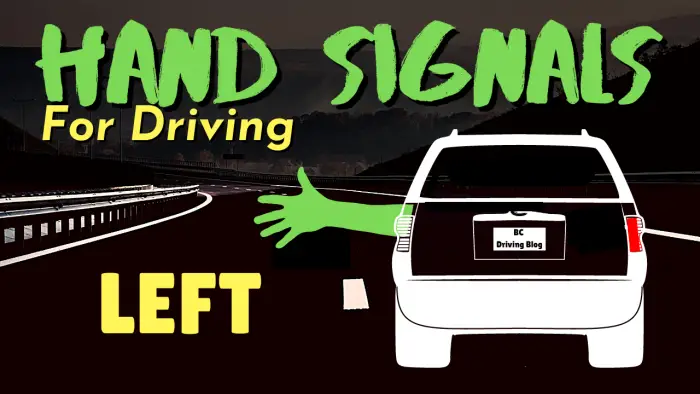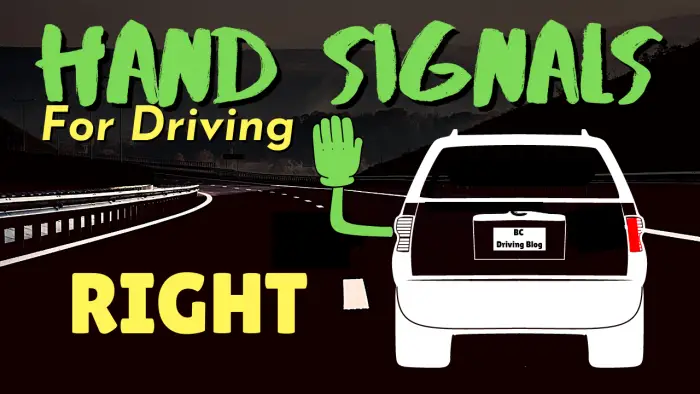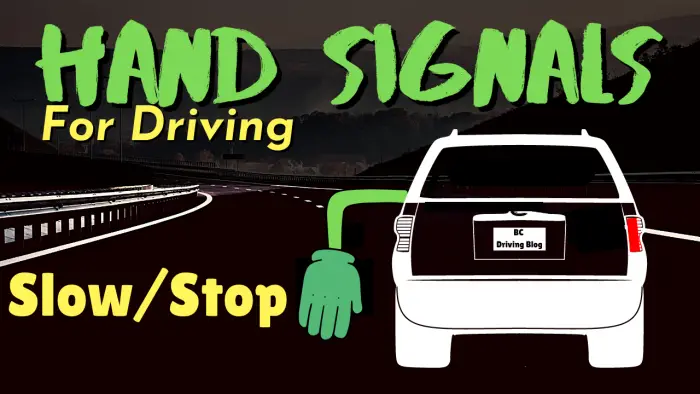Hand Signals Driving
Are you new at driving, preparing for your road test, or just curious about hand signals for driving? Despite the fact it’s 2023, we humans still don’t have flying cars. You know what else we don’t have? Car light bulbs that last forever. Therefore, we drivers need to learn hand signals for driving.
This is important because people everywhere preparing for road tests will need to know this. It’s part of basic driver education.
More importantly, it’s helpful for real-life situations when one of your four turn signal bulbs burns out and you have no other way to signal to the road users around you where you are planning to go other than your hand signals.

Hand Signals for Driving Are The Same As For Cycling
Automobile drivers must use the same hand signals for driving as bicyclists. So if you ever ride your bike, you probably know what I’m talking about.
Here’s the basic idea of hand signals for driving, since a picture is worth a thousand words:

The good news is, you don’t have to do this while driving on your road test. Just while stopped. How easy is that?
Car Hand Signals – Left
If your front or rear left turn signal bulb isn’t working, use your left hand and point your arm straight out to signal to other road users your intention to turn left or lane change to the left.

Hand Signals for Driving – Right
If there is some kind of problem with your right turn signal, use your left hand and bend your elbow so your hand is pointing towards the sky to signal to other road users your intention to turn right or lane change to the right.

Arm Signals For Driving – Slow/Stop
If your brake lights aren’t working properly, you may need to signal to other road users that you are planning to slow or stop. Drivers are incredibly conditioned to seeing bright, red lights on the vehicles in front of them when that driver applies the brakes. So, many drivers might run a risk of rear-ending you if you suddenly stop and you have no working brake lights.

Checking Your Turn Signal Light Bulbs
How do you know your turn signal lights are working?
Your turn signal may burn out one day, or it may malfunction.
So, how do you even know if you need one? I always recommend that drivers regularly check your turn signals to make sure they’re still alive and well.

Check them without leaving your vehicle
Simply drive your car up to a shiny place.
For example, drive up to a window that will show you your reflection, like at a mall parking lot or something, and then check your signals from the safety and convenience of your own automobile, with the doors locked.
This works for the rear signals, too. Simply reverse your car up to a window or any shiny object. Check them regularly, and have them fixed as soon as possible if they are burnt out.

Check them by looking outside at the vehicle
You could do it the hard way. With the car parked, get out of your car, and simply walk around the car and check them, one by one.
Note that for some vehicles, you can’t simply just turn on the 4-way flashers and walk around the car and check them. This doesn’t always give you accuracy, since the 4-way flasher sometimes runs on a separate circuit.
In that case, you’ll need to turn on the left signal and check two signals, and then turn on the right one and check two more signals. Check your four-way flashers for functionality, too!
Your vehicle may be able to “tell you” if the bulbs need replacing
This happens when the turn signal flashes extra extra extra fast, or, it makes a strange new clicking sound when you turn on your signal.
This is your car trying to “tell you” to do something. Remember that cars don’t always speak English or other languages, but they do try to tell you things in other ways. Be intuitive.
Obviously, signaling your intentions with your arm out the window isn’t the best way to signal. And, this can get cold and awkward if it’s snowing or raining. And, other road users might not see it, or they might just think you love to drive with your arm out the window or something.
But it’s certainly better than nothing. The reason cars have turn signals is so that we can kind of know where other drivers say that they are planning to go.
We can’t really trust people’s turn signals, but, we still need to use them, and we still need to know how to use hand signals as a backup plan.
Hand Signals For Driving & Driving Test – Conclusion
Hand signals are something you may never have to do. But it’s important to know how to do them, just in case.
It’s one of those things that hopefully you’ll never need, but crucial to have in your arsenal. It’s all part of being a safe driver – or as safe as you possibly can – no matter what turn signal adversities you may be dealing with.
Related:




Comments are closed